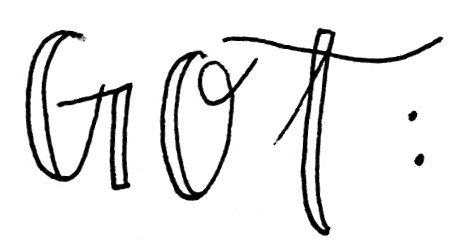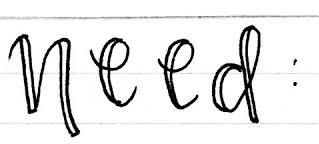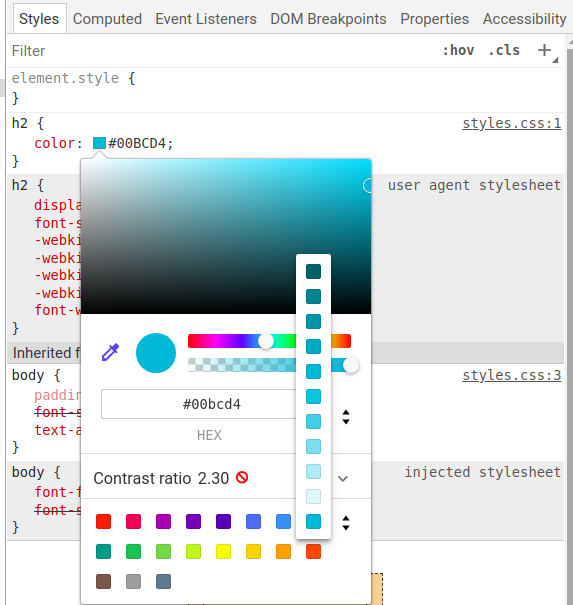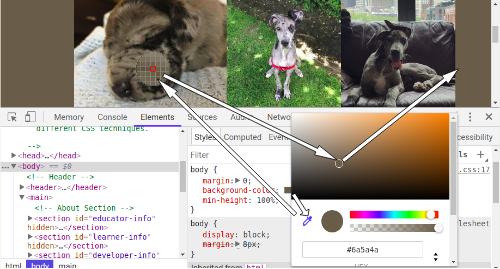CSE 154
Lecture 4: More CSS - Common Styles and Selectors
Agenda
- Administrivia
- CSS
- Review: Terminology and Syntax
idandclassattributes- Selectors (context, psuedo, etc.)
- Overview of Useful CSS Properties
Administrivia
HW1 is out
CP1 due tonight tomorrow
Consider opting in for the CP1 Showcase!
Use the extra CP day to try anything you want to practice more before HW1 (e.g. semantic tags and CSS usage)
Lecture Objectives
By the end of this lecture, you should be able to:
- Know how to assign colors on webpages using different encodings (hex, rgb, names)
- Know how to use your Chrome/Firefox inspector tool to test CSS properties
- Know how to set font properties in CSS and how/why to use defaut fonts when the first font listed is unavailable
- Know how to import and use a Google font in CSS
- Understand the differences between classes/ids
- Know how to select different elements in CSS using ids/class, grouped selectors, and context selectors
"Gots and Needs" Notecards

On one side of the notecard, write what you feel like you've "got" from lecture/section/lab/CPs.

On the other side of the notecard, write 1-2 things you feel you still need to understand, or that would help you understand this material.
Review: Basic CSS Rule Syntax
selector {
property: value;
property: value;
...
property: value;
}CSS (template)
p {
color: red;
font-family: sans-serif;
} CSS (example)
A CSS file consists of one or more "rule sets"
A rule selector specifies HTML element(s) and applies style properties
Terminology Clarifications
h1, p {
color: blue;
background-color: rgb(30, 30, 30);
}
h1 {
font-style: italic;
}
nav ul {
list-style-type: none;
color: gray;
}
CSS
How many different rule sets?
How many different rules?
How many different properties?
How many different selectors?
3
5
4
3
Common Text/Color/Background CSS Rules (more here)
| CSS Rules | Description |
|---|---|
color,
background-color
|
Foreground (text) color and background color styles |
font-family,
font-size,
font-style,
font-weight
|
Various font styles |
text-align,
text-decoration,
text-indent,
text-shadow,
text-transform
|
Various text styles |
line-height,
word-spacing,
letter-spacing
|
Line/word/letter spacing styles |
list-style-type |
List item styling (e.g. bullet styles) |
background-image,
background-repeat,
background-position,
background-attachment,
background-size
|
Various background styles |
CSS Properties for Foreground and Background Colors
p {
color: red;
background-color: yellow;
}
CSS
This paragraph uses the style above.
output
| Property | Description |
|---|---|
| color | color of an element's text |
| background-color | background color that will appear behind the element |
More about Colors in CSS
p { color: red }
h2 { color: rgb(128, 0, 196); }
h4 { color: #FF8800; }
CSS
This paragraph uses the first style above
This h2 uses the second style above
This h4 uses the third style above
output
Color names: aqua, black, blue, fuchsia, gray, green, lime, maroon, navy, olive, purple, red, silver, teal, white, yellow
RGB codes: red, green, and blue values from 0 (none) to 255 (full)
Hex codes: RGB values in base-16 from 00 (0, none) to FF (255, full)
Example: To get red font, you can use either "red", "rgb(255, 0, 0)", or "#FF0000".
Chrome Inspector: Color Picker

The Chrome inspector gives you a useful feature to look at different color code representations (e.g. HEX, RGB) as well as opacity settings, eyedropper, etc.)
When you are looking to choose colors for you page, this can be useful to see the effects real-time (then copy/paste the code to set the color in your CSS).
Chrome Inspector: Eyedropper Feature

CSS Properties for Fonts
| Property | Description |
|---|---|
| font-family | which font will be used |
| font-size | how large the letters will be drawn |
| font-style | used to enable/disable italic style |
| font-weight | used to enable/disable bold style |
| Complete list of font properties | |
font-family
h4 {
font-family: "Courier New";
}
p {
font-family: Georgia;
}CSS
This paragraph uses the first style above
This h4 uses the second style above
output
Enclose multi-world font names in quotes
More about font-family
p {
font-family: Garamond, "Times New Roman", serif;
}
CSS
This paragraph uses the above style
output
Using non-standard fonts with @font-face
Occasionally you want to use a non standard font in your website.
Webfonts is one way you might see some people do it.
@font-face {
font-family: mySerifWebFont;
src: url("webfont.ttf");
}
p {
font-family: mySerifWebFont, serif;
}CSS
When setting font-family, make sure your listed fonts all share the same classification (serif, sans-serif, monospace, cursive)
BETTER! Use Google Fonts
- Go to https://fonts.google.com
- Find the font(s) you like. Press the
+button for each - Click on the black bar that says the number of families you have selected
- Click on @import and copy the text between the
<style>and<style>tags - Paste the code into your
.cssdocument (see example here)

font-size
p {
font-size: 14pt;
}CSS
This paragraph uses the above style
output
Units:
- Pixels (px) - e.g., 16px
- Point (pt) - e.g., 16pt
- m-size (em) - e.g., 1.16em
Vague font sizes: xx-small, x-small, small, medium, large, x-large, smaller, larger,
Percentage font sizes: 90%, 120%
More about units here.
font-style,
font-weight
p {
font-style: italic;
font-weight: bold;
}CSS
This paragraph uses the above style
output
Either of the above can be set to normal to turn them off (e.g., headings)
CSS properties for text
| Property | Description |
|---|---|
text-align
|
alignment of text within its element |
text-decoration
|
decorations such as underlining |
text-indent
|
indents the first letter of each paragraph |
text-shadow
|
a colored shadow near an existing piece of text (CSS3) |
text-transform
|
controls capitalization of text |
line-height,
word-spacing,
letter-spacing
|
gaps between the various portions of the text |
| Complete list of text properties | |
text-align
blockquote { text-align: justify; }
h2 { text-align: center; }CSS
The Emperor's Quote
[TO LUKE SKYWALKER] The alliance... will die. As will your friends. Good, I can feel your anger. I am unarmed. Take your weapon. Strike me down with all of your hatred and your journey towards the dark side will be complete.
output
Can be left, right, center,
or justify (which widens all full lines of the element so that they occupy
its entire width)
text-decoration
p { text-decoration: underline; }
CSS
This paragraph uses the style above
output
Can also be overline, line through, blink or none
Effects can be combined:
p { text-decoration: overline underline; }
CSS
This paragraph uses the style above
output
text-shadow
p {
font-weight: bold;
text-shadow: -2px 5px gray;
}
CSS
This paragraph uses the style above
output
shadow is specified as an X-offset, a Y-offset, or an optional color
text-transform
I just just CAN'T make up my mind!
HTML
em {
text-transform: lowercase;
}
span {
text-transform: capitalize;
}
strong {
text-transform: uppercase;
}CSS
I just CAN'T make up my mind!
output
The
list-style-type
property
ol { list-style-type: lower-roman; }CSS
Possible values:
none: No markerdisc(default),circle, squaredecimal: 1, 2, 3, etc.decimal-leading-zero: 01, 02, 03, etc.lower-roman: i, ii, iii, iv, v, etc.upper-roman: I, II, III, IV, V, etc.lower-alpha: a, b, c, d, e, etc.upper-alpha: A, B, C, D, E, etc.lower-greek: alpha, beta, gamma, etc.- others:
hebrew, armenian, georgian, cjk-ideographic, hiragana, katakana, hiragena-iroha, katakana-iroha
CSS Properties for Backgrounds
| Property | Description |
|---|---|
background-color
|
color to fill background (previously mentioned) |
background-image
|
image to place in background |
background-position
|
placement of background image within element |
background-repeat
|
how background image should be repeated |
background-attachment
|
whether background image scrolls with page |
background-size
|
how large the background appears behind the element |
background
|
shorthand to set all backgroud properties |
| More background properties | |
background-image
body {
background-image: url("paw.jpg");
}CSS
This is the first paragraph
This is the second paragraph...
It occupies 2 lines
output
Background image/color fills the element's content area
background-repeat
body {
background-image: url("paw.jpg");
background-repeat: repeat-y;
}CSS
This is the first paragraph
This is the second paragraph...
It occupies 2 lines
output
Can be repeat (default), repeat-x,
repeat-y, or no-repeat
background-position
body {
background-image: url("paw.jpg");
background-repeat: no-repeat;
background-position: 370px 20px;
}CSS
This is the first paragraph
This is the second paragraph...
It occupies 2 lines
output
Value consists of two tokens, each of which can be top,
left, right, bottom,
center, a percentage, or a length value in px, pt, etc.
Value can be negative to shift left/up by a given amount
Methods for Styling Different Elements in CSS
- Grouping
- ids and classes
- Context selectors
- psuedo-selectors
Grouping Styles
p, h1, h2 {
color: green;
}
h2 {
background-color: yellow;
}CSS
This paragraph uses the above style.
This h2 uses the above styles
output
A style can select multiple elements separated by commas
The individual elements can also have their own styles (like
h2 above)
Body Styles
body {
font-size: 16pt;
}CSS
To apply a style to the entire body of your page, write a selector for the body (saves you from manually applying a style to each element)
* Selector
* {
font-size: 14pt;
}
section * {
border: 2pt solid black;
}CSS
To select all elements on the page, you can use the * selector.
To select all elements which are children of a parent element, you can use the * selector inside of the parent.
You should in general avoid using this selector though if 1) there is a more specific selector you can use or 2) you end up overriding the styles later.
id and class
id- Unique identifier for an element
- Only allowed one
idvalue per page - Each element can only have one
id class- Non-unique grouping attribute to share with many elements
- Many elements (even of different types) can share the same
class - Each element can have many different
classes
Example
<p id="product-12345" class="product">Puppy calendar</p>
<p id="product-133337" class="product">Cat mug</p>HTML
Both paragraphs have the same class (product), but each has its own ID
Why are these useful?
Gives you another way to talk about your content in CSS (and later in JavaScript)
#my-id {
/* ... properties ... */
}
.my-class {
/* ... other properties ... */
}
A mnemonic: .java programs compile into .class
files so...
try to remember dot
(.) class
and hash (#) id
id or class?
How do you decide whether to use an id or a class?
Probably prefer class. You can only use an id once per page, so it's good
to be a little stingy with them. classes are free.
On the other hand, if you know you are making a unique section or page element (e.g.,
submit button), id is the way to go.
A caveat:
It's easy to just make classes for everything, but don't forget that HTML is made to describe your content.
So, prefer a <p> tag over a class named paragraph
.
CSS Context Selectors
Context selectors are used to selectively style page elements
Examples:
selector1 selector2 {
properties
}
CSS
... applies the given properties to selector2 only if it is inside a selector1 on the page
selector1 > selector2 {
properties
}CSS
... applies the given properties to selector2 only if it is directly inside a selector1
on the page with no tags in between
Check out this neat game for some motivating practice :)
Context Selector Example (without >)
<p>Shop at <strong>Hardwick's Hardware</strong>...</p>
<ul>
<li>The <strong>best</strong> prices in town!</li>
<li><em><strong>Act</strong></em> while supplies last!</li>
</ul>
HTML
li strong { text-decoration: underline; }
CSS
Produces:
Shop at Hardwick's Hardware...
- The best prices in town!
- Act while supplies last!
output
Context Selector Example (with >)
<p>Shop at <strong>Hardwick's Hardware</strong>...</p>
<ul>
<li>The <strong>best</strong> prices in town!</li>
<li><em><strong>Act</strong></em> while supplies last!</li>
</ul>HTML
li > strong { text-decoration: underline; }
CSS
Produces:
Shop at Hardwick's Hardware...
- The best prices in town!
- Act while supplies last!
output
CSS
pseudo-classes
a:link { color: #FF0000; } /* unvisited link */
a:visited { color: #00FF00; } /* visited link */
a:hover { color: #FF00FF; } /* mouse over link */
CSS
output
| Class | Description |
|---|---|
| :active | an activated or selected element |
| :focus | an element that has the keyboard focus |
| :hover | an element that has the mouse over it |
| :link | a link that has not been visited |
| :visited | a link that has already been visited |
| :first-letter | the first letter of text inside an element |
| :first-line | the first line of text inside an element |
| :first-child | an element that is the first one to appear inside another |
| :nth-child(N) | applies to every Nth child of a given parent |
CSS Comments: /* ... */
/* This is a comment.
It can span many lines in a CSS file. */
p {
color: red;
background-color: aqua;
}
CSS
CSS (like HTML) is usually not commented as much as code such as Java
The // single-line comment is NOT supported in CSS
The <-- ... --> HTML comment is also
NOT supported in CSS
W3C CSS Validator
<p>
<a target="_blank" href="http://jigsaw.w3.org/css-validator/">
<img src="http://jigsaw.w3.org/css-validator/images/vcss"
alt="Valid CSS!" />
</a>
</p>HTML
Checks your CSS to make sure it meets the official CSS specifications
More picky than the web browser, which may render malformed CSS correctly
Embedding style sheets:
<style> (BAD)
<head>
<style type="text/css">
p { font-family: sans-serif; color: red; }
h2 { background-color: yellow; }
</style>
</head>HTML
CSS code can be embedded within the head of an HTML
file
This is bad style; DO NOT DO THIS (why?)
Inline styles: the style attribute (BAD)
<p style="font-family: sans-serif; color: red">
This is a paragraph</p>
HTML
This is a paragraph
output
Higher precedence than embedded or linked styles
Used for one-time overrides and styling a particular element
This is bad style; DO NOT DO THIS (why?)
Content vs. Presentation
HTML is for content; what is on the page (heading; list; code; etc.)
CSS is for presentation; how to display the page (bold; centered; 20px margin, etc.)
Keeping content separate from presentation is a very important web design principle
If the HTML contains no styles, its entire appearance can be changed
by swapping .css files (recall CSSZenGarden)
